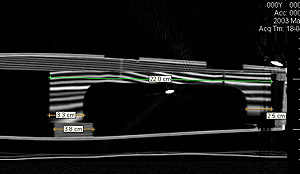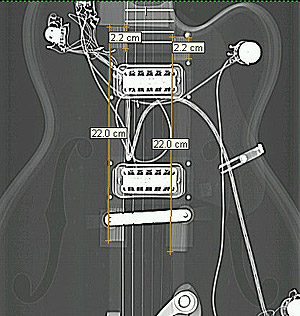|
|
What is trestle bracing, and what advantages does it offer on Gretsch guitars that feature it? Is it a modern development or a vintage design?
Good questions. The short answer to all of the above is that trestle bracing is a distinctive bracing system used inside certain Gretsch hollow-body guitar models that improves tone by increasing sustain and decreasing feedback. Gretsch developed it and first used it in the late 1950s.
Trestle bracing is a special extra. Most Gretsch hollow-body guitars and basses don’t have it. Rather, most Gretsch hollow-body instruments use a simpler internal support method called sound-post bracing, in which a vertical wooden dowel located directly under the bridge connects the top of the guitar to the back. The sound post itself doesn’t add much mass, so it affects sustain hardly at all. And since the sound post takes up very little space inside the guitar, the feedback characteristics of the body remain largely unchanged.
Far more substantial than sound-post bracing, trestle bracing consists of two bridge-like spruce braces with a wide “U” shape that are in effect trestles (hence the name). These run parallel to each other down the center of the instrument interior from the neck joint to the center of the body, ending directly under the bridge. They’re between the f holes, just beneath the sides of the pickups and bridge.
Since each rigid trestle brace has two “feet,” there are four points of attachment that are glued to the back of the guitar (versus one point of attachment for sound-post bracing). Originally, in the late 1950s and early 1960s, each of the four feet had “pilings” that served as the glued points of attachment with the back; modern-era trestle bracing dispenses with these.
The upper portions of the trestles are glued to the longer tone bar braces that also run in parallel down the underside of the top well past the bridge (and to which the pickups are fastened). This entire arrangement stiffens the top much more than a sound post does with its single point of attachment, aiding in control over feedback.

|
The great advantage of trestle bracing is that it effectively enables a hollow-body guitar to respond more like a solid-body guitar while preserving classic hollow-body tone. That is, it offers notably greater sustain and control over feedback due to the increased mass (more wood), the increased dampening of the top, and the much more substantial coupling of the top to the back.
As with several other innovations, Gretsch developed trestle bracing in the late 1950s at the behest of Chet Atkins. The great guitarist sought more sustain from his namesake 6120 hollow-body model and also wanted to subdue the feedback typical of electric hollow-body guitar design. Atkins worked with Gretsch’s Jimmie Webster and with inventor/engineer Ray Butts in devising several improvements for Gretsch guitars. Trestle bracing was one of these; it debuted in 1958 among a suite of new features including the upper-bout tone switch, “Neo-Classic” fingerboard inlays and Butts’ Filter’Tron pickup, one of the world’s first humbucking pickups (if not the first humbucking pickup).
Trestle bracing remained in use over the next few years, evolving slightly along the way. It was usually fashioned from spruce, although this wasn’t always consistent in the original era. It disappeared with the arrival of the thinner Electrotone body style in the early 1960s.
With the re-emergence of Gretsch in the modern era, trestle bracing was meticulously researched and offered once again as an authentic and tonally superior original-era design touch in several guitar models. It is a major feature on all Brian Setzer guitars and other select models, typically (but not always) referred to as “1959 trestle bracing.”
Current Gretsch models with trestle bracing include:
- G6136SLBP Brian Setzer Black Phoenix
- G6120SSL and G6120SSLVO Brian Setzer Nashville®
- G6120SSU and G6120SSUGR Brian Setzer Nashville
- G6120TV Brian Setzer Hot Rod models
- G6122-1958 Chet Atkins Country Gentleman®
- G6120-1959LTV Chet Atkins Hollow Body
- G6119-1959 Chet Atkins Tennessee Rose™
- G6136T and G6136T-LTV White Falcon™
- G6136TBK Black Falcon
- G6136TSL Silver Falcon
- G6120DE Duane Eddy Signature Hollow Body
- Gretsch Custom Shop G6118T 130th Anniversary™


